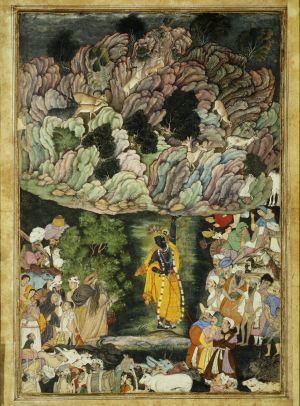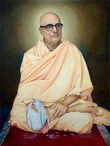 The painting is from a Persian translation of the Hindu text Harivamsa (The Legend of Hari (Krishna)). As part of his policy of reconciliation between Muslims and Hindus, Emperor Akbar (r. 1556–1605) had the Hindu classics translated into the Persian language of the court and illustrated by his court artists. This painting is one of the finest results of his plans. The god Krishna protects the people of Braj against the destructive rain sent by the god Indra.
Harivamsa [The Legend of Hari (Krishna)], Circa 1590–95; Mughal, Akbar period (1556-1605) Govardhana’s Appearance From Sri Vraja Mandala Parikrama, l984 by His Divine Grace Srila Bhakti Dayita Madhava Goswami
Maharaja Retyped from
Rays of the Harmonist Vol. II No
II Kartika l998 The narration of Govardhana’s avirbhava, or appearance, in this world and the receiving of
the name of "Giriraja" is described in the second chapter of the Vrndavana-khanda
of the Garga-Samhita, by Sri Gargacaraya. In a counsel of wise and
elderly gopas of Vraja that included Nanda Maharaja and his brother
Sananda amongst the discussion, the previously mentioned topics were debated
upon. Pandu and Bhisma raised the questions for discussion, and the narration
was then told by Sananda to Nanda Maharaja. As Sri Krishna’s desire to appear with Sri
Radha in this world correlated with the desire to descend with the desire to
descend to relieve the burden of the world, She said, "Where there is no
Vrndavana, Yamuna, Giri-Govardhana, there Radharani refuses to appear,"
Then Sri Krishna Himself sent His own dhama of eighty-four krosa,
one hundred and sixty-eight miles, of divine land, Govardhana, and Yamuna River
to the Earth. [The Lord’s transcendental Sri Vraja-mandala-dhama is not some
portion or transformation of this Earth. The Lord’s dhama has been sent
to this world.] On the western side of India is
Salmaladvipa, where the son of Drona Hill, Govardhana, descended. Govardhana’s
appearance made the demigods happily rain flowers down. Other regal mountains
headed by Himalaya, Sumeru, and so on, became happy at heart and worshiped
Govardhana. They sang the glories of Govardhana, saying, "Govardhana is
the perfectly complete svayam bhagavan Sri Krishna’s sporting place from
Goloka; Govardhana is the king of all mountains, the mukuta or crown of
Goloka, purna-brahma Krishna’s umbrella, with Vrndavana resting in its
lap. From now on, Govardhana’s name will be renowned as ‘Giriraja’," Once Pulastya, one of the seven munis,
as he was touring all the holy places, became stunned upon seeing the beautiful
trees, wonderful flowers, fruits, and gardens that the exquisitely beautiful
son of Dronacala, Giriraja Govardhana, possessed. Pulastya Muni went before
Dronacala and, showing him great worship and honor, said to him, in this way,
that he was a Kasi-vasi muni, Kasi has the Ganga, Visvesvara Mahadeva,
and sinful persons there receive sadhya-mukti, liberation as their final
goal, but they want to perform tapasya there by establishing Govardhana
at Kasi. Pulastya Muni prayed to Dronacala like this to give his son,
Govardhana, to him. Dronacala was very affectionate to his son, but fearing the
curse of the muni, "How will you be able to take Govardhana? Govardhana
is eight yojanas (64 miles) long, five yojanas (40 miles) broad,
and two yojanas (16 miles) high." This question was asked before
Pulastya Muni who had replied that he could easily take it on one hand! [The Garga-Samhita
describes Giriraja Govardhana’s breadth as eight yojanas, namely
sixty-four miles. But materialistic vision sees it and hears it as only seven
miles at present. The parikrama path is fourteen miles.] Govardhana
agreed to go along with the muni on one condition, "Muni, wherever
you place me down due to the heavy weight, there I will remain." Pulastya
Muni promised, "He would take Govardhana to Kasi, not putting him down
anywhere on the road." The powerful father of Govardhana, Dronacala,
offered pranams and then the muni lifted up Govardhana in his
right hand and slowly began to proceed forward. As he proceeded the best of the
munis came to Vraja-mandala. Upon seeing Vraja-mandala’s unparalleled
beauty where Sri Krishna’s balya-lila, childhood pastimes, and kaisora-lila,
adolescent pastimes, were performed, and remembrance of the Yamuna, gopas
and gopis, and Krishna’s pastimes with the youthful Sri Radhika and Her
associates, Govardhana had no desire to go to any other place, leaving Vraja.
In this way Govardhana became so heavy that the muni felt ill and forgot
his own promising talk and thus set Govardhana down upon the ground of Vraja.
The best of munis, upon completing his bodily purifications, again began
to request Govardhana to come and sit upon his hand as he had done previously.
But Govardhana did not accept his requests to get up. The best of the munis then tries
himself to lift but he was unable to do so. Again by the condition of the
prayer Govardhana did not want to go, so Pulastya Muni became extremely angry
and said, "Because you did not fulfil my aspiration, every day you will
decrease one sesame seed." From that time on Govardhana Hill shrunk one
sesame seed per day…
(From Sri Vraja-mandala Parikrama, 1984)
|

![[Home Page]](../grfx/bml_logo.gif)
